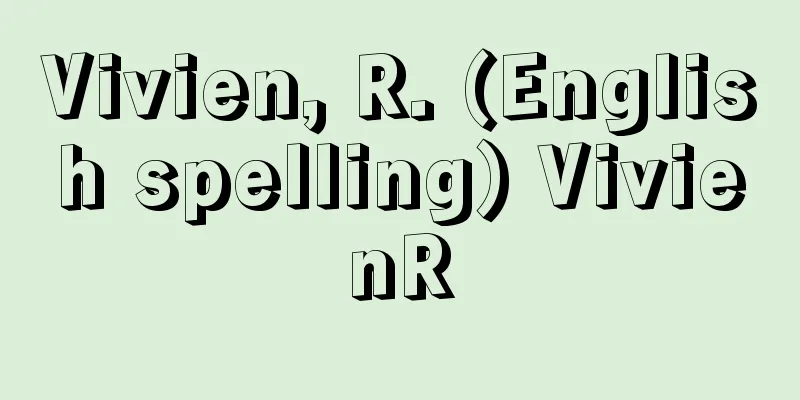Hierarchy - Hierarchie (English spelling) German

|
It refers to a pyramidal order or organization arranged in a hierarchy of superiors and subordinates. It is also called hierarchy and is translated as hierarchical control, rank system, and status hierarchy. Its origin is said to be from the Greek word meaning "divine rule." Originally it meant the order of angels in the heavenly realm, but it eventually came to refer to the order of clergy in the church, and further to the status order in medieval society. When used as a concept in social science, it was first used to refer to a status hierarchy in which a personal relationship of servitude was established, which was at the same time expressed and justified as a hierarchy of values, forming a rigid hierarchical relationship of king-lord-vassals-subjects. However, as modern and contemporary society became organized based on a completely contrasting principle, the concept of hierarchy came to be used to refer to its unique organizational principle. M. Weber aptly called this organizational principle the "hierarchy of duties." In modern large organizations, jobs are divided and distributed in a fixed manner from a functional and technical perspective, and the chain of command is organized in a way that subordinates the lower ranks to the higher ranks, so that the organization is operated efficiently as if it were a single machine. Weber called this pyramidal system of jobs a "hierarchy of jobs," but today such systems are generally called hierarchies. However, this hierarchy has inherent weaknesses, such as the transformation of functional and technical stratification into a ranking of values, the privileging of authority, and the allowing of arbitrary and tyrannical behavior by superiors. In order to overcome these weaknesses, calls were made to break away from bureaucracy to technocracy with the advent of the knowledge and information society. In the modern information society, this hierarchy is contrasted with the networking supported by new information technologies. [Yazawa Shujiro] "Sociology of Domination" by M. Weber, translated by Koshiro Sera, 2 volumes (1960, 1962, Sobunsha) [References] | | | |Source: Shogakukan Encyclopedia Nipponica About Encyclopedia Nipponica Information | Legend |
|
上位・下位関係に整序されたピラミッド型の秩序ないしは組織のことをいう。ヒエラルキー、ハイアラーキーhierarchyともいわれ、階統制、位階制、身分階層制などと訳されている。語源はギリシア語で「神聖な支配」を意味しているといわれている。元来は天上界における天使の序列を意味したが、やがて教会における聖職者の序列をいうようになり、さらには中世社会の身分秩序をさすようになっていった。 これが社会科学上の概念として用いられる場合には、まず初めは、人格的な隷属関係が成立し、しかもそれが同時に価値の序列として表れ正当化されることによって形成された身分階層が、国王―領主―家臣―領民といった固定的rigidな上下関係を構成するようになった身分階層制をさすものとして使用された。しかし、近・現代社会がそれとはまったく対照的な原理に基づいて組織化されていくにつれて、その特有の組織原理をさすものとしてこのヒエラルヒーの概念は用いられるようになったのである。その組織原理を、M・ウェーバーは適切にも「職務のヒエラルヒー」とよんでいる。 近代的な巨大組織においては、職務が機能的、技術的な観点から固定的に分割・分配されるとともに、指揮・命令系統は下が上に従属するという形で整序され、その結果、その組織はあたかも1個の機械のように能率的に運営されていく。この職務のピラミッド型の体系をウェーバーは「職務のヒエラルヒー」とよんだのであるが、今日ではそうした体系を一般的にヒエラルヒーとよんでいる。もっともこのヒエラルヒーは、機能的・技術的階層化が価値の序列に転化したり、権限が特権化したり、上位者の独断・専制を許したりする弱点を内在しており、その弱点を克服するために、知識・情報社会化に伴ってビューロクラシー(官僚制)からテクノクラシーへの脱皮が叫ばれたのである。 現代情報社会においては、このヒエラルヒーは新しい情報テクノロジーに支えられたネットワーキングと対比される。 [矢澤修次郎] 『M・ウェーバー著、世良晃志郎訳『支配の社会学』全2巻(1960、1962・創文社)』 [参照項目] | | | |出典 小学館 日本大百科全書(ニッポニカ)日本大百科全書(ニッポニカ)について 情報 | 凡例 |
Recommend
Deutsch, OH (English spelling) DeutschOH
…In contrast, his symphonies, chamber music, and ...
slacks
…In Japan, as Western clothing became more common...
Choi Ho - The best
A politician of the Northern Wei dynasty in China...
Sword fittings
The exterior of a sword, also called koshirae, is ...
Dromia dehaani (English spelling)
This is a large crab of the Crustacea family, Cryp...
Ariyama Tomb - Ariyama Tomb
This square tomb, 45m on each side, is located in ...
Obai - Obai
A deciduous shrub of the Oleaceae family (APG cla...
Pilea cadierei (English spelling) Pilea cadierei
…[Tetsuichi Yahara]. … From [Pilea] … [Takabayash...
Light of Grace - Oncho no Hikari
…This theory of epistemology became the Francisca...
Hydrogen embrittlement
… [Hydrogen embrittlement] Steel, which has a bod...
Permanent gas - gas
A substance that was thought to be a gas that cou...
Sphenophyllum
An extinct genus of arthropod ferns in the order C...
Cadmeia - Cadmeia
…When his sister Europa was abducted by Zeus, he ...
Tropical -
〘noun〙① The region on Earth from the equator to th...
King Ikeda
Years of birth: Years of birth and death unknown. ...



![Higashiawakura [village] - Higashiawakura](/upload/images/67cc99674d380.webp)





